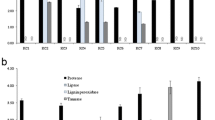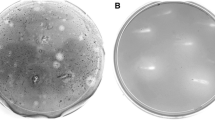Abstract
Cellulose degrading bacteria were isolated from the intestinal fluid of the silver cricket Lepisma Sp. and a culture was developed anoxigenically in the cellulose degrading medium following standard laboratory techniques. The cellulolytic activity of the microbe was examined in a broth culture using Whatman 42 filter paper as the source of insoluble cellulose. Activity was measured spectrophotometrically (620nm) following Anthrone reaction of the culture filtrate and the sugar produced was quantified as a factor of time. The pH optimum was found to be between 7 and 8. Temperature profile optimum was between 30–37°C.
The microbes appeared as white colonies on a solid medium. Morphologically the bacterium is a gram-positive nonspore forming rod which was tentatively identified as a new strain of Cellulomonas sp.
Similar content being viewed by others
References
Bagnara, C., Toci, R., Gandin, T.C. and Belaich, J.P. (1985) Isolation and characterization of a cellulolytic microorganism, Cellulomonas fermentus sp. nov. Int. J. Syst. Bacteriology, 35, 502–507.
Gottschalk, G., Andersen, J.R. and Hippe, H. (1981) The genus Clostridium New medical aspects. In: Starr, M.P., Stolp, H., Truper, H.G., Balows, A. and Schlegel, H.G., eds. The Prokaryotes, Vol. II. Springer Verlag: Berlin, pp. 1767–1803.
Kelly, W.J., Admundson, R.V. and Hopcraft, D.H. (1987) Isolation and characterization of strictly anaerobic cellulolytic spore former: Clostridium chartatabidum sp. nov. Arch. Microbiology, 147, 169–173.
Khan, A.W., Meek, E., Sowden, L.C. and Colvin, J.R. (1984) Mendation of the Genus Acetivibrio and description of Acetivibrio cellulosolvens sp. nov., a non-motile cellulolytic mesophile. Int. J. Syst. Bacteriology, 147, 169–173.
Murray, W.D., Sowden, L.C. and Colvin, J.R. (1984) Bacteroids cellulosolvens sp. nov. a cellulolytic species from sewage sludge. Int. J. Syst. Bacteriology, 34, 185–187.
Patel, G.B., Khan, A.W., Agrew, B.J. and Colvin, J.R. (1980) Isolation and characterization of an anaerobic cellulolytic microorganism. Acetivibrio cellulolyticus gen. nov. sp. nov. Int. J. Syst. Bacteriology, 30, 179–185.
Plummer, D.T. (1988) An introduction to practical biochemistry (3d ed.). Tata McGraw Hill Publishing Co. Ltd.: New Delhi, India, Chapter 9.
Rogosa, M. (1974) Genus III, Ruminococcus Gram positive Cocci. In: (Buchanan, R. E. and Gibbous, N. E. eds.) Bergey's manual of determinative bacteriology (8th ed.). Williams and Wilkins Co: Baltimore, pp. 525–527.
Sirockin, G. and Cullimore, S. (1969) Practical microbiology. McGraw Hill: London, Chapters 6, 7, 8, 9, 10.
Smith, L.D.S. and Hobbs, G. (1974) Genus III. Clostridium-Endospore forming rods and cocci. In: Buchanan, R. E. and Gibbous, N. E. eds.) Bergey's manual of deteminative bacteriology (8th ed.). Williams and Wilkins Co: Baltimore, pp. 551–572.
Zeikus, J.G. and Wolfe, R.S. (1972) Methanobacterium thermoautotrophicum sp. nov. an anaerobic, autotrophic, extreme thermophile. J. Bacteriology, 109, 707–713.
Author information
Authors and Affiliations
Rights and permissions
About this article
Cite this article
Chakraborty, N., Sarkar, G.M. & Lahiri, S.C. Cellulose degrading capabilities of cellulolytic bacteria isolated from the intestinal fluids of the silver cricket. The Environmentalist 20, 9–11 (2000). https://doi.org/10.1023/A:1006691524607
Issue Date:
DOI: https://doi.org/10.1023/A:1006691524607




